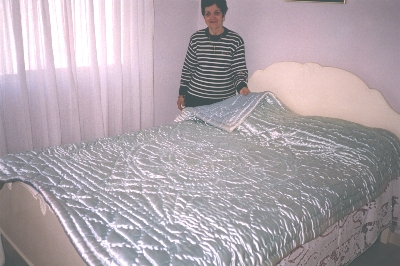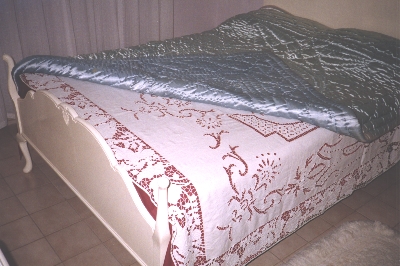Quilt No.920NC - Nina Conomos
2070 x 1740mm
This quilt was made in the 1950s by a Sydney quiltmaker whose name is unknown but who possibly came from the Greek island of Kastellorizo. It was ordered by Nina Conomos' mother Marigo Iconomou. It is now owned by Nina's daughter Rosalie Theodoros. It is not used.
"Nina's Paploma
In the early 1950's, Nina Conomos' mother Marigo (Kanari) Iconomou ordered this traditional blue-satin 'paploma' (quil) from a Sydney quiltmaker who may have come from the tiny Greek island of Kastellorizo, as had Marigo with her two daughters in 1947.
Their harrowing journey of migration had begun four years earlier in 1943, when British troops captured Kastellorizo, then evacuated all its inhabitants - first to Cyprus and then to British-controlled Palestine. In September 1945 these Kastellorizian refugees were to be returned to their island. Fifteen-year old Nina, her sister Katina, and mother were among the nearly 500 people on board the British vessel 'Empire Patrol' when it caught fire. A rescue operation was mounted, but tragically, thirty-three Kastellorizians were lost. Eventually those rescued were returned to their island, now left desolate from the war and a ravaging fire. After two miserable years the family was able finally to migrate to Australia. Between their enforced evacuation and the tragic shipwreck, Nina's family lost absolutely everything. But Kastellorizians are well known for their ability to rise above the terrible adversities which history has dealt them.
In peaceful Brisbane, where her brother Agapitos, and two sisters, Despina and Theresia, were already established, Nina was able to begin a different life. 'I met my lovely husband, and we've made a good life together'. Nina and Nick have three children Rosalie, James and Maria; and five grandchildren. Her Australian-made Greek quilt is a reminder of both the early years of tragedy and loss, and her Australian years which have brought peace and prosperity."
[Written by Lula Saunders, adapted from interview 6/9/00 for the National Quilt Register]


Related Quilts:
It is padded with hand carded wool.
1950 x 1935mm
1550 x 1321mm
2235 x 1854mm
1920 x 1756mm






